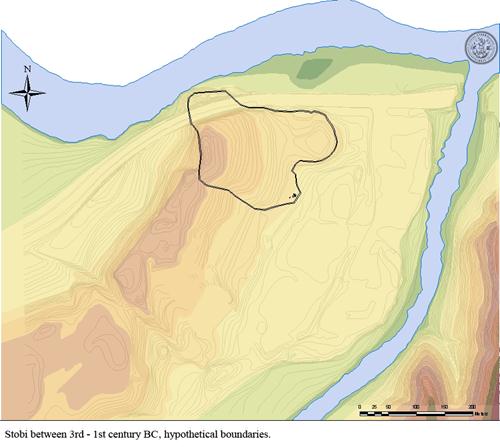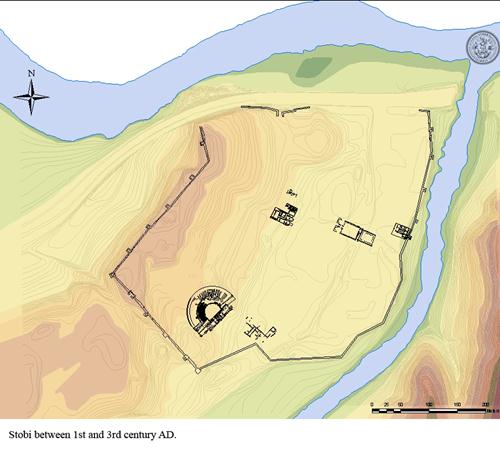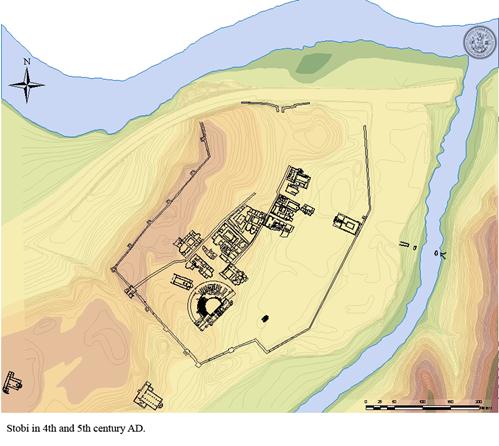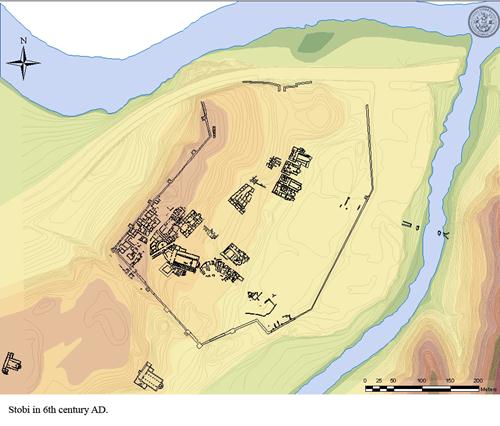The historiographical records and the archaeological excavations give us the opportunity to build up a proper historical picture of the continuous habitation and the events linked to Stobi.
The discovered remains from the archaic and the classical period probably mark the beginning of the town. Their small quantity and the lack of written sources do not allow certain conclusions about the settlement and its size.
 The earliest written evidence of Stobi is found in Livy’s Ab Urbe Condita. It refers to the triumph of Phillip V against the Dardanians. Livy says that the battle happened near Stobi in 197 BC. The next line that refers to our town informs that the river Erigon (Crna) flows into Axios (Vardar) near the "old town" of Stobi. His third information about Stobi takes us to the Roman occupation of Macedonia and the year 167 BC, when Stobi became the main trade center of salt in the third meris. The archaeological excavations revealed enough data from the Hellenistic settlement and its necropolis which allows us to follow the further development of the town.
The earliest written evidence of Stobi is found in Livy’s Ab Urbe Condita. It refers to the triumph of Phillip V against the Dardanians. Livy says that the battle happened near Stobi in 197 BC. The next line that refers to our town informs that the river Erigon (Crna) flows into Axios (Vardar) near the "old town" of Stobi. His third information about Stobi takes us to the Roman occupation of Macedonia and the year 167 BC, when Stobi became the main trade center of salt in the third meris. The archaeological excavations revealed enough data from the Hellenistic settlement and its necropolis which allows us to follow the further development of the town.
The trade and the location of Stobi were the main impulse for constant development during the Roman rule.  Being at the crossroad of the road along Axios River (Vardar) and the road that connected Via Egnatia and Via Militaris, Stobi became one of the most significant towns in Macedonia. From 1st – 3rd century, during the Pax Romana, Stobi had changes in the urbanization, a demographic expansion and occupied the largest area in its history. In the period of the Augustus reign, Stobi became Civium Opiddum Romanorum and later it reached the status of Municipium. Although the dominant population was autochthonous, there were many citizens who had Ius Italicum and belonged to the tribes of Aemilia and Tromentina. There also was a Jewish community in Stobi. By an inscription, we know the name of Tiberius Claudius Policharmos who rebuilt the synagogue and built his home next to it. He is signed as the father of the Jewish community. During the rule of the emperor Vespasian (69 -79 AD), Stobi minted its own coins which were used in the local trade until the reign of Emperor Elagabalus (218 - 222 AD). The archaeological excavations have uncovered several buildings from this period such as the theatre, the defensive wall, the water supply system, the synagogue, the so – called Casa Romana, parts of streets, a building below the Civil Basilica and the public building with arches known by the working name of “Roman Forum”. The explorations point out that the town was destroyed in the second half of the 3rd century. Although an earthquake is not excluded, the reason for this devastation is usually applied to the Goths and Heruli who ravaged the Balkans in 267/9 AD.
Being at the crossroad of the road along Axios River (Vardar) and the road that connected Via Egnatia and Via Militaris, Stobi became one of the most significant towns in Macedonia. From 1st – 3rd century, during the Pax Romana, Stobi had changes in the urbanization, a demographic expansion and occupied the largest area in its history. In the period of the Augustus reign, Stobi became Civium Opiddum Romanorum and later it reached the status of Municipium. Although the dominant population was autochthonous, there were many citizens who had Ius Italicum and belonged to the tribes of Aemilia and Tromentina. There also was a Jewish community in Stobi. By an inscription, we know the name of Tiberius Claudius Policharmos who rebuilt the synagogue and built his home next to it. He is signed as the father of the Jewish community. During the rule of the emperor Vespasian (69 -79 AD), Stobi minted its own coins which were used in the local trade until the reign of Emperor Elagabalus (218 - 222 AD). The archaeological excavations have uncovered several buildings from this period such as the theatre, the defensive wall, the water supply system, the synagogue, the so – called Casa Romana, parts of streets, a building below the Civil Basilica and the public building with arches known by the working name of “Roman Forum”. The explorations point out that the town was destroyed in the second half of the 3rd century. Although an earthquake is not excluded, the reason for this devastation is usually applied to the Goths and Heruli who ravaged the Balkans in 267/9 AD.
After the catastrophe, the town was rebuilt and during the 4th and the 5th century suffered lots of changes, concerning urbanization. Most of the buildings presented nowadays belong to this period. A new fortification wall was built at the East side towards the end of the 4th or the beginning of the 5th century. It is located to the West from the old wall and it is founded on top of some buildings from the 1st – 3rd century.
 One of the most significant events in the history of Stobi is the appearance of Christianity. The name of the first bishop Budius is noted at the first ecumenical council in Nicaea in 325 AD. The Old Episcopal Basilica in Stobi was built in the 4th century and it is considered to be the oldest Christian church in R. Macedonia. In 388 AD the emperor Theodosius I visited Stobi from where he published two edicts which banned the heretic gatherings and the public discussions about religion. The sacred architecture discovered at Stobi, especially the Episcopal Basilica of the bishop Philip from the 5th century, recognize Stobi as an important Christian centre with established traditions. The fact that Stobi was the capital of the province Macedonia Secunda made some scholars think that Stobi was not just an Episcopal polity but a metropolis. The bishops from Stobi took part in the Christian councils until the 7th century when the polity existed just formally.
One of the most significant events in the history of Stobi is the appearance of Christianity. The name of the first bishop Budius is noted at the first ecumenical council in Nicaea in 325 AD. The Old Episcopal Basilica in Stobi was built in the 4th century and it is considered to be the oldest Christian church in R. Macedonia. In 388 AD the emperor Theodosius I visited Stobi from where he published two edicts which banned the heretic gatherings and the public discussions about religion. The sacred architecture discovered at Stobi, especially the Episcopal Basilica of the bishop Philip from the 5th century, recognize Stobi as an important Christian centre with established traditions. The fact that Stobi was the capital of the province Macedonia Secunda made some scholars think that Stobi was not just an Episcopal polity but a metropolis. The bishops from Stobi took part in the Christian councils until the 7th century when the polity existed just formally.
The most famous citizen of Stobi lived in the 5th century. His name is Ioannes Stobaeus and he is known as an ancient scholar who compiled an anthology of four books, consisting literature from Homer to the 5th century. His work is very useful because he preserved numerous extracts from lost ancient works.
In 447 AD Stobi was destroyed by the Huns as many other towns on the Balkans. The event, recorded by the sources, is also documented by the fired strata containing Hun weapon. This marked the beginning of a turbulent period and the gradual demise of Stobi.
On their way to Dyrrachium, Theodoric and the Ostrogoths robbed Stobi but this was not as disastrous as the attack of the Huns.
The beginning of the 6th century is marked by the huge earthquake in 518 AD which ruined many towns in Dardania and Macedonia Secunda. The movements of the Slavs, Avars, Kutrigurs and other tribes brought the destruction of the ancient towns at the Balkans towards the end of the century. This also meant an end of the urban life in Stobi.

In the centuries that followed, Slavs settled the area, but judging by the discovered graves the level of population was poor.